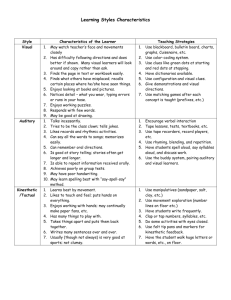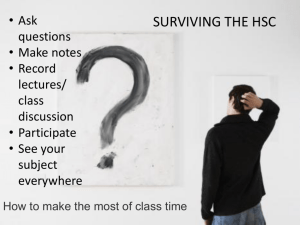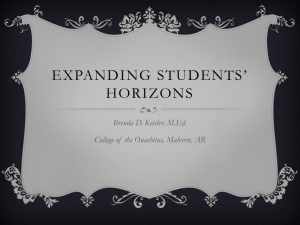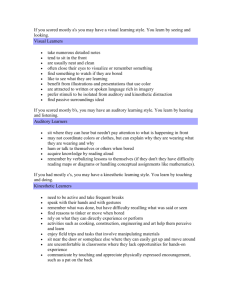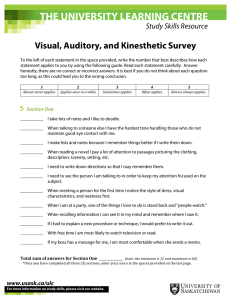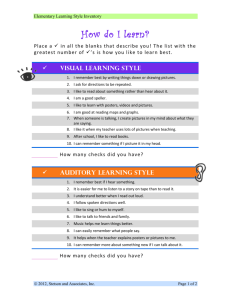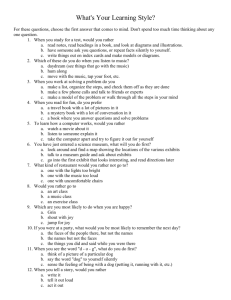Learning styles
advertisement
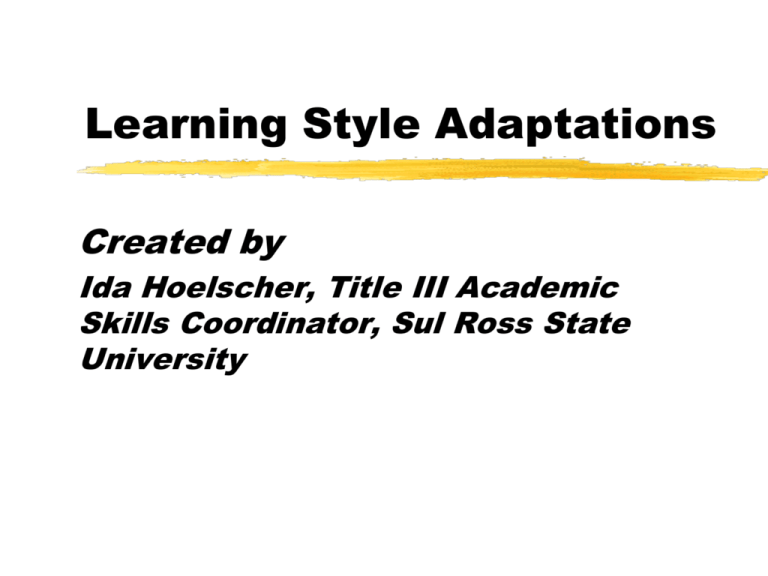
Learning Style Adaptations Created by Ida Hoelscher, Title III Academic Skills Coordinator, Sul Ross State University How do you learn? Learning starts at birth. Culture plays a role in how you learn, as does experience. The learning styles we cover are visual, auditory, kinesthetic, individual, group, oral-expressive, written-expressive, sequential, and global. Visual Learner: Learns best by seeing how it’s done Takes lots of notes, uses workbooks Uses flash cards, films, handouts, overhead projectors, etc. Uses highlighters to mark textbooks Studies better in a quiet place, usually by themselves Looks at pictures, illustrations, changes in font, captions, etc. Visual - continued Writes questions from key terms, then writes a summary answer. Writes ideas into other words and reconstructs images in different ways Sits in the front and watches the speaker’s face and body language Draws a picture of math problems, lists what is or is not known & the steps Visual - continued Chooses instructors & classes that use an abundance of visual materials (ex. Films, handouts, notes on the board, graphs, etc.) Asks self questions by turning captions into questions Anticipates & practices possible questions for essay tests & also practices outlining answers Auditory Learners: Learn best by listening Should take lecture courses that emphasize discussion, questionanswer periods & oral reports Should use study groups to discuss the material and review for tests so that you hear it Describe pictures, visuals, & concepts to yourself as you study Auditory - continued Rehearse the steps to math problems aloud & explain the steps of the problem Review flash cards by reciting them aloud Read difficult passages aloud & carry on imaginary conversations with the author Create questions from key terms in your notes & recite answers to yourself Auditory - continued Summarize & tape your notes then listen to them while you do other activities that do not require attention Tutor other students; this increases your knowledge as you listen to yourself explain to someone else Discuss the material with a tutor or your instructor Bodily-Kinesthetic Learner: Learn by touching or doing, need action from the body Pace as you learn, lecture to yourself Study in the question/answer format; shift your body position from side to side Study with someone else by discussing, listening, arguing and questioning key points Kinesthetic - continued Keep your study periods short, 25 minutes. Then take a walk, do push-ups, or visit a friend for at least 5 minutes; then continue; do 4-5 small sessions not one big session Change subjects and the study activities on a regular basis, then go back later Stay active while you read - annotate the book, make questions, mark answers, add examples from your own knowledge Kinesthetic - continued Record your notes, then listen to them as you walk, jog, cook, drive, etc. Take instructors that emphasize labs, field trips, & experience learning Choose a study area that gives you room to move, at least from desk, to bed, to floor, etc.

